BOISE, Idaho (AP) — An Idaho prosecutor says he will seek the death penalty against an Idaho inmate charged with killing a man while he was on the lam during a 36-hour escape from prison.
Skylar Meade, 32, has already been sentenced to life in prison after pleading guilty to the March escape from a Boise hospital, where prison officials had taken him for treatment of self-inflicted injuries. But the first-degree murder charge is in a different county, and Meade has not yet had the opportunity to enter a plea in that case. Meade's defense attorney, Rick Cuddihy, did not immediately respond to a message seeking comment.
Nez Perce County Prosecutor Justin Coleman announced Friday that he will seek the death penalty if Meade is convicted in the shooting death of James Mauney.
“After long and careful consideration I have decided to seek the death penalty in this case,” Coleman wrote in the press release. “The senseless and random killing of Mr. Mauney and the facts surrounding what lead to his death, warrants this determination.”
Meade's alleged accomplice in the escape, Nicholas Umphenour, 29, has also been indicted in connection with Mauney's death, and had not yet had the opportunity to enter a plea. Umphenour is also awaiting trial on charges including aggravated battery and aiding and abetting escape after a judge entered a not guilty plea on his behalf. Umphenour's defense attorney, Brian Marx, did not immediately respond to a voice message.
The case began in the early morning hours of March 20 after the Idaho Department of Correction brought Meade to Saint Alphonsus Regional Medical Center for treatment of self-inflicted injuries. Prosecutors say that as correctional officers prepared to take Meade back to the prison around 2 a.m., an accomplice outside the hospital began shooting.
Nicholas Umphenour shot two of the correctional officers, prosecutors say. A third officer was shot and injured when a fellow police officer mistook him for the shooter and opened fire. All three of the officers survived their injuries.
Meade and Umphenour fled the scene, investigators said, first driving several hours to north-central Idaho.
Mauney, an 83-year-old Juliaetta resident, didn't return home from walking his dogs on a local trail later that morning. Idaho State Police officials said Mauney's body was found miles away.
The grand jury indictment says Meade is accused of either shooting shooting Mauney as he tried to rob the man or aiding another person in the killing. Police have also said that Meade and Umphenour are suspects in the death of Gerald Don Henderson, 72, who was found outside of his home in a nearby town. Henderson's death remains under investigation and neither Meade nor Umphenour have been charged.
Police say the men left north-central Idaho not long after, heading back to the southern half of the state. They were arrested in Twin Falls roughly 36 hours after the hospital attack.
Police described both men as white supremacist gang members who had been incarcerated at the Idaho Maximum Security Institution in Kuna, at times housed in the same unit.
At the time of the escape, Meade was serving a 20-year sentence for shooting at a sheriff’s sergeant during a high-speed chase. Umphenour was released in January after serving time on charges of grand theft and unlawful possession of a weapon.
Meade is scheduled to be arraigned Thursday on the murder charge.

FILE - In this photo made from body camera footage and released by the Twin Falls, Idaho, Police Department, Skylar Meade, right, is arrested in Twin Falls on Thursday, March 21, 2024. An Idaho prosecutor says he will seek the death penalty against an Idaho inmate charged with killing a man while he was on the lam during a 36-hour escape from prison. (Twin Falls Police Department via AP, File)
BALTIMORE (AP) — Lamar Jackson was solid in Baltimore's biggest game of the season so far.
Then, after one of the star quarterback's rare slip-ups, one of his teammates delivered the play of the day.
Jackson threw three touchdown passes and Marlon Humphrey scored on a fourth-quarter interception return to help the Ravens pull even with Pittsburgh atop the AFC North with a 34-17 victory over the Steelers on Saturday.
Pittsburgh (10-5) would have clinched the division with a victory, but now the teams are deadlocked after the Ravens (10-5) won for just the second time in the last 10 games in this series. Baltimore clinched a playoff berth. The Steelers had already done so.
“It was cool to get a pick-6, but clinching a spot in the playoffs, to beat the Steelers, I'm just happy that the guys came in, put in the work, and we just took care of business,” Humphrey said. “I felt that this team has had our number over the years. Just take care of business, man. I felt like the performance we put on wasn't perfect, but I felt like that's what we were supposed to do.”
Russell Wilson threw two touchdown passes, the second of which tied the game at 17 with 5:14 left in the third quarter. Jackson answered with a 7-yard scoring strike to Mark Andrews, and after Pittsburgh turned the ball over on downs, a 44-yard run by Derrick Henry put the Ravens in the red zone.
That drive came to nothing when Jackson was intercepted for just the fourth time this season, but then Humphrey — who was celebrating the recent birth of his son Duke — picked off Wilson and went 37 yards to the end zone to give Baltimore a cushion in a series that’s been razor-thin of late. The previous nine games between the Steelers and Ravens were decided by seven points or fewer.
“My whole family's in town to help out with my wife and everything,” Humphrey said. “I was texting her before. I'm supposed to go pick her up from the hospital, discharge her with the baby. So there's a lot of just great things that happened this week.”
Jackson improved to 2-4 against Pittsburgh as a starter. This was his first time facing the Steelers at home since 2020.
“I feel like we've been busting our behind all season long, had ups and downs throughout this whole season, but to clinch a playoff against a great team like that, that's great,” Jackson said. “That means we're moving in the right direction.”
Henry rushed for 162 yards.
Pittsburgh entered the game with a plus-18 margin in turnovers, but the Ravens had the edge in that department Saturday. Baltimore recovered three of its own fumbles and had two big takeaways.
“We didn’t control the run game. We never did. When you don’t, you’ve got to do some splash plays or win the turnover battle in a significant way, and we didn’t do that either,” Steelers coach Mike Tomlin said. “There were some balls on the ground that we didn’t get. Then obviously we turned the ball over going in -- it took seven points off the board -- and they had a pick-6. The rest is history, as they say.”
Jackson found Isaiah Likely for a 9-yard touchdown to open the scoring. Wilson answered with a 1-yard scoring pass to MyCole Pruitt, and the Steelers appeared poised to take the lead when the veteran quarterback broke loose for a 19-yard run in Baltimore territory.
But Ar'Darius Washington delivered a punishing hit on Wilson at the end of that play, jarring the ball loose. Kyle Van Noy recovered for the Ravens at the Baltimore 4.
The Ravens then drove 96 yards and took a 14-7 lead on Jackson's 14-yard touchdown toss to Rashod Bateman.
Wilson threw a 12-yard TD to Cordarrelle Patterson to tie it in the third.
Jackson set a team record with his 37th touchdown pass of the season, and he's now up to a career high of 3,787 yards.
Ravens receiver Zay Flowers had five catches for 100 yards, surpassing 1,000 on the season.
Henry has exceeded 1,500 yards rushing for the fourth time. He's now up to 1,636, a mark he's only surpassed once — in his 2,027-yard campaign of 2020.
Steelers CB Joey Porter Jr. injured his calf, and WR Ben Skowronek hurt his hip. ... Baltimore RB Justice Hill left the game because of a concussion.
Both teams play on Christmas Day to wrap up stretches of three games in 11 days. Pittsburgh hosts Kansas City on Wednesday and Baltimore plays at Houston.
AP NFL: https://apnews.com/hub/nfl

Pittsburgh Steelers quarterback Russell Wilson, left, gestures while scrambling against Baltimore Ravens defensive tackle Broderick Washington during the first half of an NFL football game, Saturday, Dec. 21, 2024, in Baltimore. (AP Photo/Stephanie Scarbrough)

Baltimore Ravens tight end Mark Andrews (89) celebrates with wide receiver Rashod Bateman (7) after scoring a touchdown during the second half of an NFL football game against the Pittsburgh Steelers, Saturday, Dec. 21, 2024, in Baltimore. (AP Photo/Nick Wass)

Baltimore Ravens wide receiver Zay Flowers reacts after making a catch against the Pittsburgh Steelers during the second half of an NFL football game, Saturday, Dec. 21, 2024, in Baltimore. (AP Photo/Stephanie Scarbrough)

Baltimore Ravens running back Derrick Henry runs with the ball against the Pittsburgh Steelers during the first half of an NFL football game, Saturday, Dec. 21, 2024, in Baltimore. (AP Photo/Stephanie Scarbrough)

Baltimore Ravens running back Derrick Henry busts a long run against the Pittsburgh Steelers during the second half of an NFL football game, Saturday, Dec. 21, 2024, in Baltimore. (AP Photo/Stephanie Scarbrough)

Pittsburgh Steelers running back Cordarrelle Patterson (84) catches a touchdown pass as Baltimore Ravens linebacker Malik Harrison defends during the second half of an NFL football game, Saturday, Dec. 21, 2024, in Baltimore. (AP Photo/Nick Wass)

Baltimore Ravens head coach John Harbaugh talks to an official during the second half of an NFL football game against the Pittsburgh Steelers, Saturday, Dec. 21, 2024, in Baltimore. (AP Photo/Nick Wass)

Pittsburgh Steelers head coach Mike Tomlin looks on during the second half of an NFL football game against the Baltimore Ravens, Saturday, Dec. 21, 2024, in Baltimore. (AP Photo/Stephanie Scarbrough)

Baltimore Ravens quarterback Lamar Jackson, left, and wide receiver Rashod Bateman (7) react after connecting for a touchdown pass and catch against the Pittsburgh Steelers during the first half of an NFL football game, Saturday, Dec. 21, 2024, in Baltimore. (AP Photo/Nick Wass)

Baltimore Ravens quarterback Lamar Jackson throws a pass against the Pittsburgh Steelers during the first half of an NFL football game, Saturday, Dec. 21, 2024, in Baltimore. (AP Photo/Stephanie Scarbrough)

Baltimore Ravens cornerback Marlon Humphrey (44) celebrates his pick-6 interception score with teammates during the second half of an NFL football game against the Pittsburgh Steelers, Saturday, Dec. 21, 2024, in Baltimore. (AP Photo/Nick Wass)

Pittsburgh Steelers quarterback Russell Wilson, bottom right, hits the turf as Baltimore Ravens cornerback Marlon Humphrey, left, returns an interception for a touchdown during the second half of an NFL football game, Saturday, Dec. 21, 2024, in Baltimore. (AP Photo/Stephanie Scarbrough)






















